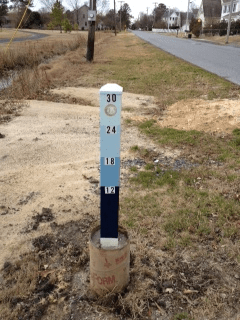The University of Maryland’s Environmental Finance Center (EFC) begins work this month on the region’s first Municipal Online Stormwater Training (MOST) Center, a web-based resource to help municipalities within the Chesapeake Bay Watershed access and implement innovative stormwater management techniques to improve water quality in the Bay. The project was made possible by a grant from the National Fish and Wildlife Foundation (NFWF), who will provide $350,000 a year for the next five years to launch and operate the center. Developed in partnership with the Low Impact Development Center (LIDC), the MOST Center will be completely virtual; it is expected to become the most wide-reaching and comprehensive stormwater initiative to date, eliminating the accessibility issues, budget restraints, and lack of expertise that often keep communities from successfully implementing effective stormwater management.
“Communities in the Chesapeake Bay are faced with the challenges of limited capacity and very few resources available to help them meet their stormwater management needs and obligations,” explains Joanne Throwe, Director of the Environmental Finance Center. “Many of these communities have provided direct feedback, saying that they need an online one-stop resource that provides specific municipal stormwater program technical and management information and training. We are very excited to get this program off the ground.”
The comprehensive program, which will be provided at no cost to municipalities, will offer the necessary skills to create and implement effective stormwater projects, from modernizing infrastructure to developing localized leadership teams. At the heart of the program, communities will gain the “fundamental building blocks” of storm water programs, which include leveraging existing resources, developing innovative strategies and creating new approaches to financing. Modeled after the Massive Open Online Course Model catching fire at universities across the country, the MOST Center will offer assistance and training to communities throughout the watershed, regardless of size, budget or accessibility. According to Throwe, the MOST Center will implement a number of resources in an effort to build the best comprehensive training program possible. This includes sharing relevant case studies, as well as technical and financial information from national programs and key organizations, such as the American Public Works Association, the American Planning Association, the American Society of Civil Engineers and The Water Environment Federation. Training will also be strengthened by input and expertise from many local Chesapeake Bay organizations.
Understanding that each community is unique and will be at different stages of knowledge and implementation, the MOST Center will offer a series of tools to gauge current knowledge and allow them to participate at the appropriate level, then advance participants as training progresses. A sliding scale of training modules will be developed to address a variety of levels of expertise, from the most basic to more advanced skill sets. This flexibility will eliminate the technical intimidation factor for audiences who may not have prior experience or expertise with stormwater management, while also providing complex and comprehensive information for the more seasoned trade professionals. The center will offer municipalities a variety of incentives for participation and completion, including continuing education hours, professional development hours, certificates of completion and recognition for projects.
The EFC is well versed in providing stormwater assistance to municipalities in the mid-Atlantic region. Over the past several years, they have assisted seventeen communities in developing stormwater policy and procedures as part of their Stormwater Financing and Outreach Unit, with dedicated stormwater revenue sources in Berlin, Oxford and most recently the City of Salisbury, Maryland. Currently, the EFC has water resource related projects in 12 locations throughout the Chesapeake Bay Watershed and has recently expanded their reach to include a satellite office in California.
Over the next year, the EFC and LIDC will create the technical and contextual framework and foundation for the training program, tapping area leaders and organizations for input and feedback. The EFC also plans to use the first year to develop a network of relationships with professional, institutional and government stakeholders, having them act as advisors, and to partner in content creation and training. The EFC anticipates the new virtual online center will go live in early 2016, with the objective of becoming self-sustaining by the end of the project period.
“Stormwater is by far one of the biggest threats to the health of the Bay,” says Throwe. “Arming communities with the tools to diminish their impact on bay resources will have lasting implications for the economic, social and environmental well-being of the state.”
The University of Maryland’s EFC is the largest Environmental Finance Center in the country, managing and implementing a number of environmentally minded projects throughout the mid-Atlantic Region. The Municipal Online Stormwater Training Center was one of 13 projects officially announced this past September as part of the Chesapeake Bay Stewardship Fund. To learn more about the MOST Center and other efforts by the EFC, visit the EFC’s website at www.efc.umd.edu.

